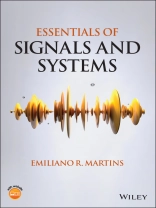Novel approach to the theory of signals and systems in an introductory, accessible textbook
Signals and Systems have the reputation of being a difficult subject. Essentials of Signals and Systems is a standalone textbook aiming to change this reputation with a novel approach to this subject, teaching the essential concepts of signals and systems in a clear, friendly, intuitive, and accessible way.
The overall vision of the book is that traditional approaches to signals and systems are unnecessarily convoluted, and that students’ learning experiences are much improved by making a clear connection between the theory of representation of signal and systems, and the theory of representation of vectors and matrices in linear algebra. The author begins by reviewing the theory of representation in linear algebra, emphasizing that vectors are represented by different coordinates when the basis is changed, and that the basis of eigenvectors is special because it diagonalizes the operator. Thus, in each step of the theory of representation of signals and systems, the author shows the analogous step in linear algebra. With such an approach, students can easily understand that signals are analogous to vectors, that systems are analogous to matrices, and that Fourier transforms are a change to the basis that diagonalizes LTI operators.
The text emphasizes the key concepts in the analysis of linear and time invariant systems, demonstrating both the algebraic and physical meaning of Fourier transforms. The text carefully connects the most important transforms (Fourier series, Discrete Time Fourier Transform, Discrete Fourier Transforms, Laplace and z-transforms), emphasizing their relationships and motivations. The continuous and discrete time domains are neatly connected, and the students are shown step-by-step how to use the fft function, using simple examples.
Incorporating learning objectives and problems, and supported with simple Matlab codes to illustrate concepts, the text presents to students the foundations to allow the reader to pursue more advanced topics in later courses.
Developed from lecture notes already tested with more than 600 students over six years, Essentials of Signals and Systems covers sample topics such as:
* Basic concepts of linear algebra that are pertinent to signals and systems.
* Theory of representation of signals, with an emphasis on the notion of Fourier transforms as a change of basis, and on their physical meaning.
* Theory of representation of linear and time invariant systems, emphasizing the role of Fourier transforms as a change to the basis of eigenvectors, and the physical meaning of the impulse and frequency responses.
* What signals and systems have to do with phasors and impedances, and the basics of filter design.
* The Laplace transform as an extension of Fourier transforms.
* Discrete signals and systems, the sampling theorem, the Discrete Time Fourier Transform (DTFT), the Discrete Fourier Transform (DFT), and how to use the fast fourier transform (fft).
* The z-transform as an extension of the Discrete Time Fourier Transform.
Essentials of Signals and Systems is an immensely helpful textbook on the subject for undergraduate students of electrical and computer engineering. The information contained within is also pertinent to those in physics and related fields involved in the understanding of signals and system processing, including those working on related practical applications.
Jadual kandungan
Chapter 1: Review of Linear Algebra in a two-dimensional Euclidian space
1.1 Introduction
1.2 Vectors, scalar product, and bases
1.3 Linear operators
1.4 The closure relation
1.5 Eigenvectors and eigenvalues
1.6 Representation of operators
1.7 The Dirac notation
Chapter 2: Introduction to the theory of representation of signals
2.1 Definition of signals
2.2 The convolution
2.3 The impulse function, or Dirac delta function
2.4 Convolutions with impulse functions
2.5 Impulse functions as a basis: the time domain representation of signals
2.4 A different basis: the frequency domain representation of signals
Chapter 3: Introduction to the theory of representation of systems
3.1 Definition of systems
3.2 Properties of systems
3.3 Time domain representation of LTI systems
3.4 Eigenvectors and eigenvalues of LTI systems
3.5 Frequency domain representation of LTI systems
3.6 General relationship between input and output in LTI systems
3.7 The physical meaning of eigenvalues of a LTI system: the impulse and frequency responses
3.8 Conservation of frequency in LTI systems and applications in other fields.
Chapter 4: Example of application in electric circuits
4.1 Electric circuits as LTI systems
4.2 Phasors and impedances as a useful trick to find the eigenvalues dispensing with the time domain representation
Chapter 5: Filters
5.1 Definition of a filter
5.2 Ideal filters
5.3 Why ideal filters are only ideal
5.4 Low pass filters
5.5 High pass filters
5.6 Bandpass filters
5.7 Introduction to advanced filter design: Butterworth and Chebyshev filters.
Chapter 6: The Laplace Transform
6.1 Motivation: stability in LTI systems
6.2 The Laplace transform as a generalization of Fourier Transforms
6.3 The inverse Laplace transform
6.4 Regions of convergence
6.5 Properties of Laplace Transforms
Chapter 7: The Discrete Time Fourier Transform (DTFT)
7.1 Discrete signals.
7.2 Fourier representation of discrete signals
7.3 The sampling theorem
7.4 The DTFT
7.5 Properties of the DTFT
7.6 Energy of a discrete signal
Chapter 8 The Discrete Fourier Transform (DFT)
8.1 Motivation
8.2 The DFT
8.3 Relationship between DFT and DTFT
8.4 Properties of DFT
8.5 The fft
Chapter 9: Discrete systems
9.1 Introduction
9.2 Properties of discrete systems
9.3 Representation of discrete LTI systems
Chapter 10: The z-transform
10.1 Motivation: stability in LTI discrete systems.
10.2 The z-transform as a generalization of the DTFT
10.3 Mapping between z and s
10.4 Regions of convergence of the z-transform.
10.5 Properties of the z-transform
Mengenai Pengarang
Emiliano R. Martins majored in electrical engineering at the University of São Paulo (Brazil), then obtained a master’s degree in electrical engineering from the same university, another master’s degree in photonics from the Erasmus Mundus Master in Photonics (European consortium), and a Ph D in physics from the University of St. Andrews (UK). He has been teaching signals and systems in the Department of Electrical and Computer Engineering of the University of São Paulo (Brazil) since 2016. He is also the author of Essentials of Semiconductor Device Physics.












